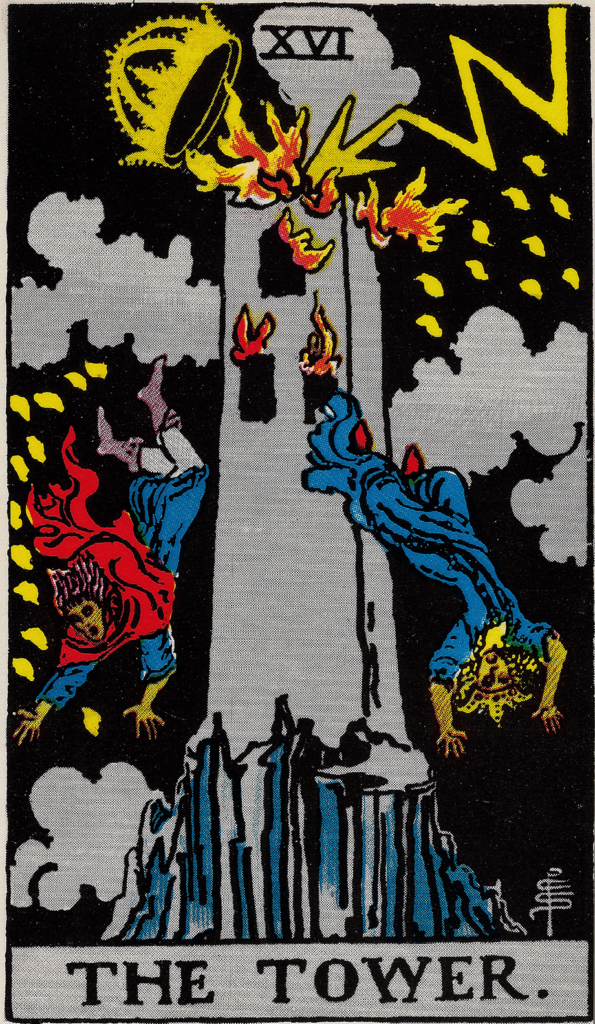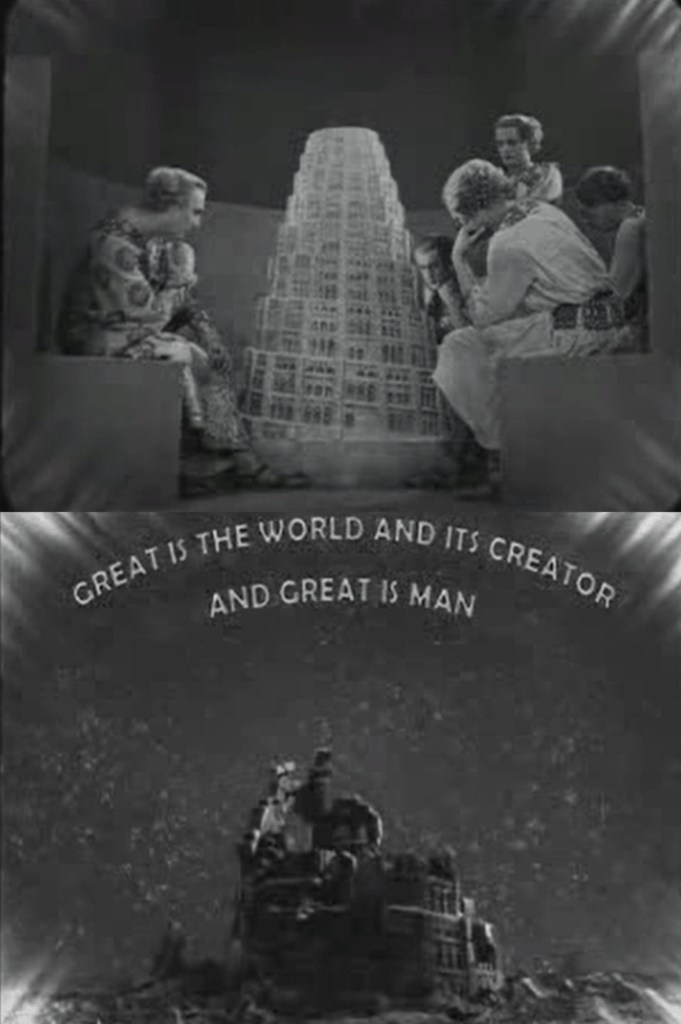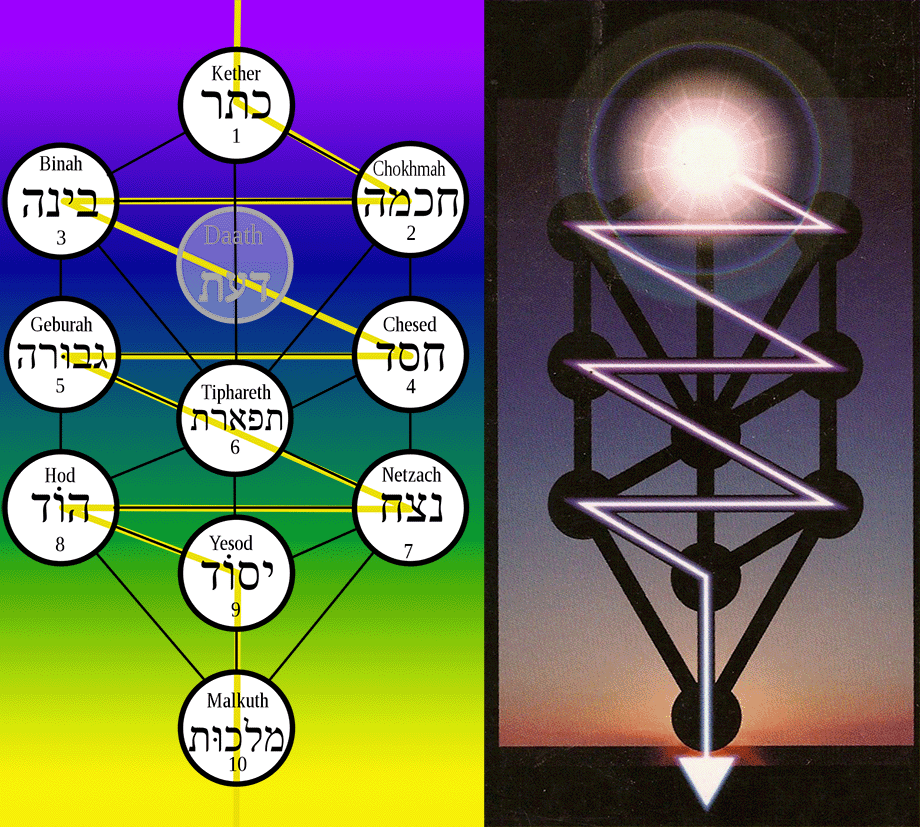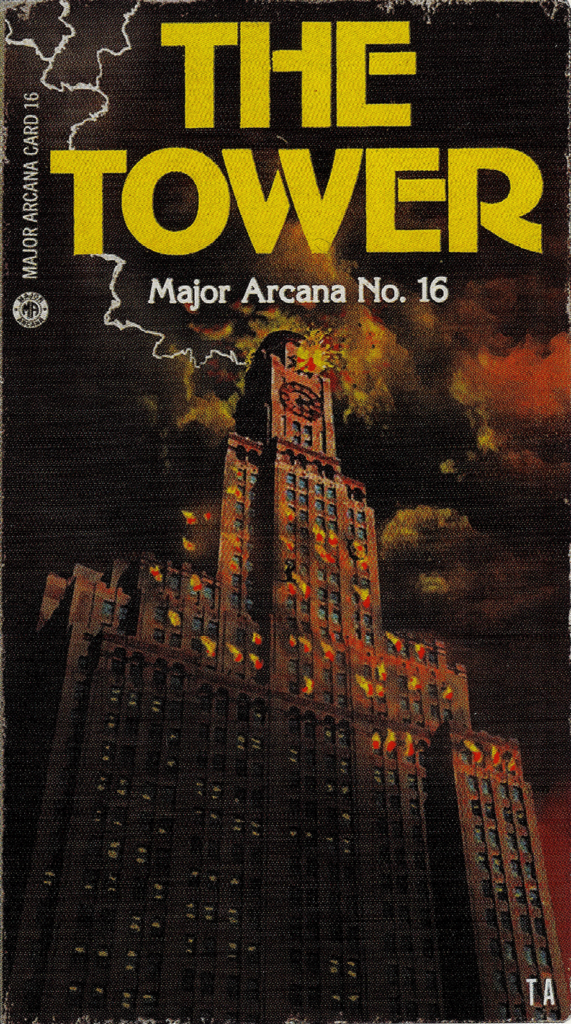Come, let us build us a tower whose top may reach unto the stars! And on the top of the tower we will write the words: Great is the world and its Creator! And great is Man!
Metropolis – Thea Von Harbo
Card XVI has evolved in recent times to become a surrogate for the Death card. Death, being dreaded by both readers and clients, has been mollified to mean “the transition from one state to another”. The cards, not accepting that the portent of doom should be wholly removed from the deck, have shifted this cloud of darkness and destruction over a few spaces, and now place it on the lightning struck Tower.

This card is marked by a high three windowed Tower atop a mountain. The Tower was topped by a crown, which has been blasted away by the oddly shaped lightning bolt. fire and smoke issue out from it now, and rain down on the earth below. Along either side are falling figures, plummeting to their doom. One is a king in a blue robe with red shoes. Kings do not fair well in the middle of the Major Arcana. The other has a blue tunic and a red cape. The sky behind them is black.
One can see from this imagery why the Tower made such a ready herald of impending disaster and loss. I have, in a previous article, offered an alternative message, and it is one that I give to my clients when this card shows up. But as this series of articles is about the intuitive expression of the visual card, I will explore that first, before going into additional rabbit holes.
There are two possible origins for the ideas on this card. The first, alluded to in the quote from Fritz Lang’s silent 1927 masterpiece, is the Tower of Babel from Genesis. Babel is an expression of human vanity and ambition, as well as a convenient “just-so” story to account for the different languages of humanity.
If you aren’t familiar with it, basically after Adam and Eve left the Garden, there was a great deal of begetting until there were a lot of people wandering around the Earth. They all spoke a common language because they had all descended from the same couple (let’s not even begin to consider the DNA implications of that). So they decided to get together and build a city, and in the middle of the city they would build a great Tower that would reach “unto Heaven”.

While the film might be viewed as a Communist anthem extoling the virtues of the worker’s loosing their chains, the overall message is that the problem in such societies is the disconnect between the elites who envision with high ideals, and the people who are tasked with practically carrying them out.
The early Soviet and Nazi states were presented with glowing accolades of a new world order that did away with the failures of the old. Turns out that autocracy is harder to uproot than it appears on paper, and power corrupts.
Lang would ultimately flee the Nazis and make films in Hollywood, though it’s hard to say he ever made another film that is as influential to the cinema as Metropolis. It echoes through science fiction to the present day, and gives us our earliest version of a future dystopia.
God, not interested in having any uninvited visitors popping in, promptly “confounded their language” so that they couldn’t understand each other, and so affected a work stoppage. This is the third time in Genesis that the deity moves to limit human potential. The first is when they are forbidden to eat of the fruit of the Tree of Knowledge of Good and Evil. The second, is when they are cast out of the Garden, to keep them from the fruit of the Tree of Life which could make them immortal. And then he intervenes to prevent them from reaching the heavens. It’s always interesting to me that there is this idea of “things Man should not know” included in the Judeo-Christian teachings. The very term “forbidden fruit” comes from the Genesis story. While certainly some parts of Mosaic law are practical and helpful for a civilized society, this doctrine of Divine Secrecy makes very little sense outside of it limiting such knowledge to an elite priest class.
The Hebrews didn’t invent that, of course. They borrowed it from their neighbors (or conquerors) in Egypt and Mesopotamia. The priest class and the priest-king class rose from less structured tribal roles as human populations moved from nomadic hunter-gatherers to settled farmers and builders. The impetus for building such structures is also not practical. If we look to the earliest of human settlement, we find that, while there are clearly scared spaces, the majority of the architecture is centered around utility and defense. The ancient villages of Catal Hyuk and Mohenjo Daro are ramshackle mudbrick tenements, with entrances on the roofs. They resemble more the pueblo dwellings of the American Southwest than the Ziggurat of Ur or the Great Pyramid. But these latter structures were built to honor god-kings. These persons were so powerful within their own city-states that they were considered to be corporeal with the sun god or the sky god. Like Jesus Christ who would come centuries later, and a few of the wackier Roman emperors who demanded such treatment, their followers actually believed they were in the presence of a living god. Outside of certain cult experiences, we have a hard time getting our heads around that in the modern world. And unfortunately these cult experiences frequently end in horrific tragedy.
In some versions of the Tarot de Marseilles and some of the Thelemic and Hermitic offshoots of the earlier 20th century, this card is called the House of God. There is much speculation as to whether this notation is a sarcastic comment on the worldliness of the Medieval church, or some more esoteric message about the impermanence of all created things. Paul Huson suggests that this trump, like many of those around it, are derived from scenes in early morality plays. The segment he believes is covered here is the razing of Hell.

Unlike a number of the 70s disaster pics, this one typically doesn’t re-run anymore. The events of September 11, 2001 brought the reality of a skyscraper fire too close to the public consciousness. Ironically, the film was supposedly inspired by the World Trade Center towers that were under construction at the time.
In certain early Christian writings, there is a a tradition that between the Crucifixion on Friday and the Resurrection on Sunday, Jesus Christ had to proceed through the same afterlife as any human would. This, according to doctrine, was necessary because he was truly human, and that was a requirement for him being able to provide salvation to the rest of the human race. During this afterlife journey, he transforms death into life and brings the message of redemption to all the souls in Limbo, Purgatory, and finally Hell, where he overthrows the Devil and basically tears the place down. Per Huson this drama is played out in the Hanged Man (or Crucifixion), Death, Temperance (the Alchemy of Immortality/Resurrection), The Devil, and The Tower. So in this context, the “House of God” represents the Scourging of Hell, and the expected redemption of the damned who were then taken into Heaven.
Curiously the Tower, like the Devil before it, is also missing from the Visconti-Sforza originals, and we can only accept that the later replacement is a faithful copy of that older design. As it matches more closely the stylings of later decks like the Marseilles, it is hard to say if this Tower image is not part of that later visual tradition. While it’s easy to understand how the Devil card might be employed by magicians and monsignors for malefic or beneficial outcome, the Tower card doesn’t offer such an obvious reason for it’s being lost. It might also have been utilized as an omen of bad luck, or a harbinger of doom, in casting curses. Or it may simply have been lost at random. As giving meaning to the apparent randomness of the draw of a card is at the heart of the Tarot, it can sometimes be our habit to attach meaning where none exists.
There are meanings aplenty in the iconography Pamela Smith gives us in this card. Over the years they’ve come to be universally associated with doom and gloom, but I will offer some other potential ways of looking at this.

As I discussed in an earlier article, the simplest way to transform our experience of the Tower card is to identify with the bolt of lightning rather than the ruined building. This means that we are the catalyst for change. We are the divine force shattering the edifice of vanity and folly. I think there’s some justification for this interpretation, other than just its pragmatic usefulness.
That lightning bolt doesn’t look like the sort we expect to see. It’s not the zig-zag “zap” from cartoons and comic books. Nor is it the tree shaped fan of a real lightning strike. This very stylized bolt reminds me more than anything of the “lightning path” inherent in Kabbalistic teaches about the transmission of the Crown energy of Kether down to the world of manifestation Malkuth. No, it’s not exact, but it is close enough in my mind to think that Pixie was intending to get us thinking in that vein. And why not, as this Lightning Flash down the Tree of Life is an expression of the Divine Energy becoming apparent and affecting the mundane world of the flesh. And that is precisely what is happening in the Tower card.
That this Tower is topped with a now displaced crown, rather than conventional turret or roof is also an unusual message. The crown rising in the background of Temperance is similar to this one, but if we want to find one that is closest, we need to go back to the Emperor. This is, in fact, an Imperial Crown, and may be an iconographic left-over from Medieval times. Going back to the name “House of God” we can read this as metaphor for the collapse of the Roman Empire and subsequent replacement with a more or less Christian state. Oddly though, this type of crown, as well as that on the Emperor is more in keeping with that successor state, called the Holy Roman Empire (which as historians frequently point out, was not any of the three). So we are again left wondering why such a structure would be blasted off the top of this ruined building. The Marseilles equivalent has an actual crenelated turret and it is being blasted off by a breath of heavenly fire. So I think perhaps we need to read the crown as being connected to the lightning. It is the presence of Kether – the Crown – the Divine appearing as an apparition, much as the crown dawning in the Temperance card. It’s location and angle are the same as the blasted top of the Marseilles Tower, but there the similarities in depiction end, so we are playing with secret language here.
The Tower in flames, the falling bodies (one with his earthly crown, the same style that lays at the feet of Death’s pale horse) and the rain of fire are fairly consistent with earlier models of the card. If we begin to dissect them in terms of traditional symbolism, we find that the left figure in the blue and red garb may be seen as connecting with Christ. The red representing the blood of sacrifice and redemption, and the blue representing the purity of sinlessness. The Virgin is frequently depicted in these colors as well, signaling our understanding that we are looking at, at least in an iconographic sense, the Catholic dogma regarding the resurrection. The opposite figure, of the fallen king, ironically has bloody shoes. This perhaps alludes to the role of civil authorities in the martyrdom and oppression of the early church.
But again both the institutions of the church and the state are being cast down from this disaster. This might signal a more modern rejection that occurs at the beginning of the past century, because the earlier versions make no such distinction. But from the esoteric perspective, we can look upon it as the rejection of a worldly belief structure, in the face of Divine Revelation. Neither the established religious ideology or the established political authority is real. Both are a surface only, and when the bolt of Absolute Truth is shown, their falseness is betrayed and dissolved.

If we look at the Tower as an impending doom to our own interests it conveys aught but fear and dread. If we determine that this represents the destruction of an established order, which we regard ourselves (rightly or wrongly) as separate from, then the news is slightly better, assuming we have no moral compunction to watching other humans suffer.
But there is a third way to look at it, and that is as an incentive to examine the staid and perhaps too rigid parts of our own thinking, and accept the possibility that change is a positive, even if the process is temporarily horrifying. What does not survive the Tower’s fall was not strong enough to be relied upon. Even if it appeared to be useful, and beautiful, and important, if it cannot withstand such a shock, it would ultimately fail us at a critical point, doing even greater damage.
This theme is a powerful one for our present day. Byron Ballard has spoken on multiple occasions that we are in, or have just passed through Tower time. By her definition, this is a time when the old order of things is being blown apart and transformed. What has functioned -for good or ill- in the past has ceased to provide what the world requires, and so the world is shattering it.
It is tempting to subscribe to this metaphor, but I try to view things from the broader perspective of human society. The experience of Tower time is not unique to our present circumstance, nor are we the first society to verbalize a similar idea, even if that label was not applied. The changes to the established order of things was going on when Smith designed these cards. One might argue that the shift would culminate in World War I, because human civilization was significantly transformed by that event, and society was irrevocably altered.
Yet I can cite the same circumstances in the middle of the 19th century with the American Civil War, and the outcomes of the various Revolutions of the 18th century, coming as they did in the wake of the Enlightenment.
My point is that these transformations are a constant. The old order is frequently being blown apart and rebuilt in a new form. The Tower has strong foundations. While it is comforting to believe that we will jettison all the negative aspects and “get it right this time”, history teaches that it is harder to abandon certain forms than we expect. The Tower is burning, but it is not burned. The pinnacle upon which it sits is a high one. Doubtless other kings and prelates will rise to scale that height.
If it is your house that is burning, then you will see this as a disaster.
If it is your enemy’s house that burns, you will see this as a miracle and a wonder.
Two bodies fall from the Tower.
It is therefore important to remember that we all share the same world that is burning. Wishing for it’s destruction and collapse does not leave us without impact. We are not immune to the consequences of it’s collapse.
We need to be mindful of Old Kronos devouring his children lest one destroy him. Had he not that habit, Zeus would not have been motivated to seek his destruction.
Regardless of whether “Tower time” is present, past, or future, it is without argument life-altering. It signifies a change so profound that nothing that comes afterward will ever be quite the same again.
Because we see it as a lightning flash, we assume that it is an instant: explosive, cataclysmic, shocking. But such change can be quiet, subtle, and potentially hard to pinpoint.
We can look to the fall of the Berlin Wall as a profound event that marked the collapse of the corrupt Soviet system and the end of the Cold War. Yet the series of events leading up to that moment were varied, and their connection only visible in hindsight. The lightning bolt meandered its way over the world for almost a century before it struck on that night in 1989.
And sadly, it’s clear that particular Tower has not completely toppled.
The lightning is still striking, slowly, inexorably, in ways that will perhaps only be perceived by our descendants, should the world survive for them to exist.
In the meantime, I next turn my attention to the first of three cards expressing what I call “celestial” ideation. Next week we will discuss the Star. We are only five cards from the end of this particular exercise.
By summer’s end I will have to go back to thinking up new topics in a more organic fashion, as I have not the energy (at present) to do this with the remaining 56 cards of the Minor Arcana. Perhaps it’s time I turn that energy toward putting such information in a book. The world can surely use another Tarot book, right?
Thank you for continuing to find something here worth your time. I look forward to welcoming you in again next week.

